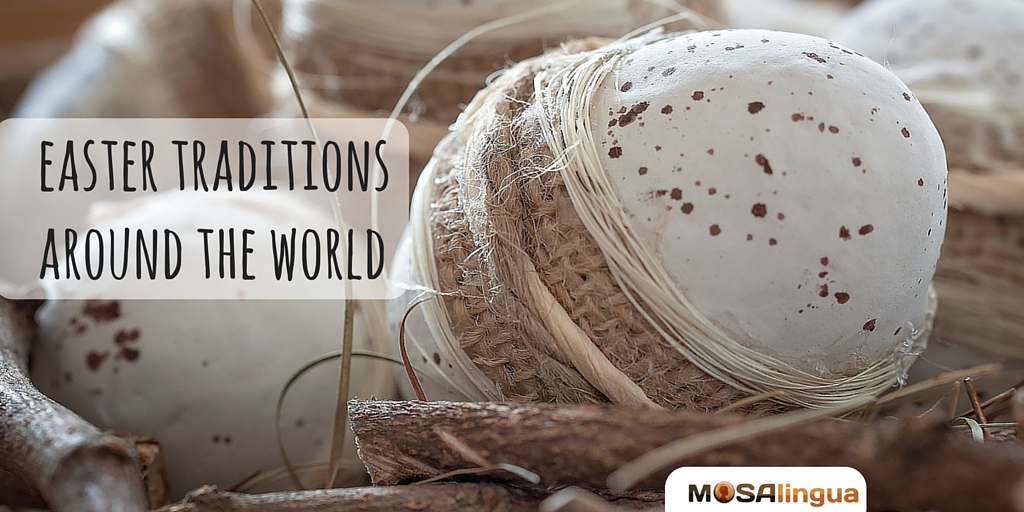There are many customs and Easter traditions celebrated around the world. Some customs are similar to each other while some differ greatly. However and wherever you celebrate, Easter traditions are all meant in good fun. Keep reading to learn how people coming from different parts of the world celebrate it and how they wish each other a “Happy Easter”.
Easter Traditions Celebrated Around the World
Brazil

On Palm Sunday, Catholics and other Christians celebrate Jesus Christ’s entry into Jerusalem, the week before his death and resurrection. Also referred to as Passion Sunday, the day marks the beginning of the Holy Week, which concludes on Easter Sunday.
On Easter Sunday, it is customary to give chocolate eggs and bunnies as gifts to loved ones, which is a common Easter tradition in most countries. In some Brazilian towns, people reenact the last day of Christ, including his arrest, trial and crucifixion.
Germany

The last play was in 2010, which means you’ll have to wait until 2020 to see the next one! German tourists come from all over to see this play, which is performed from May to October and is at times fully booked so make your reservation in advance.
United Kingdom

And guess what the winners get? You probably guessed it. They get to eat their pancakes! 😉
Greece

On the small island of Corfu, it is tradition on Easter Saturday to throw clay pots off of balconies which marks the first resurrection. Followed by midnight mass and then Easter dinner to break lent.
On Easter Sunday, lamb is cooked on a skewer and can be smelled throughout the streets in Greece. Easter eggs are coloured red only, representing the blood of Christ. Children play a game where they try to crack each other’s eggs without cracking their own.
France

This has been a tradition for the past three decades, however it is believed to have been started by Napoleon when he demanded a large dish of eggs be served to his soldiers as they passed through the countryside. Each year the omelet has been getting bigger and bigger. Last year alone, over 10,000 eggs were used to make it!
Spain

One of the festivities takes place in Verges, Catalonia near Barcelona, where men dress as skeletons and perform a dance of death. La Dansa de la Muerte de Verges, as it’s called in Spanish, takes place on Holy Thursday and is complimented by locals carrying ashes and clocks around a medieval village. This dance represents the final judgement when it is decided if a person’s soul goes to heaven, purgatory or hell.
USA

Portugal
In Portugal, the major celebrations start on Good Friday where throughout the country straw dolls are hanged and burned over large bonfires to represent the mistreatment of Judas.
Many Latin American countries have the same tradition such as in Mexico, Venezuela, Uruguay and Brazil, where the straw doll is typically hanged on Good Friday and burned on Easter Sunday.
Romania

During Easter mass, people gather in church to light their candles from the holy flame which is spread by the priest, called the fire of God. Locals bring their candles back home and lightly scorch their doorway entrance in the shape of a cross three times, symbolic of the Holy Trinity. This is a tradition for blessing their home.
Australia

This is why they have the Easter Bilby, which also happens to be an endangered species and was introduced as part of a campaign run by animal activist organisations.
How to say “Happy Easter” in different languages
Just out of curiosity, let’s see how people around the world wish each other Happy Easter in their own language.
- Spanish: Feliz Pascua
- Portuguese: Feliz Páscoa
- German: Frohe Ostern
- Italian: Buona Pasqua
- French: Joyeuses Pâques
- Greek : Καλό Πάσχα (Kalo Pas-ha)
- Romanian: Paşte Fericit
- Russian: Счастливой Пасхи (Schastlivoy Pas-hi)
This week we have prepared a special surprise for you… follow us to get more details! In the meantime, feel free to share your own traditions and customs, as well as how you say “Happy Easter” in your language. We’re always keen to hear from our readers and learn about cultures from around the world.
Related posts:
Start learning a new language today

Good news: we can help!
More good news: you can get started for free! Start your free trial now and for the next 15 days, take advantage of the most effective language learning method on the market!
Vocabulary flashcards, videos with subtitles, audiobooks, articles adapted to your level – with MosaLingua Premium (Web & Mobile), you’ll have access to all this and more. Get started right now. It’s free—and risk-free—to try!






Comments